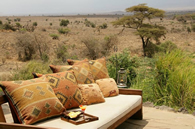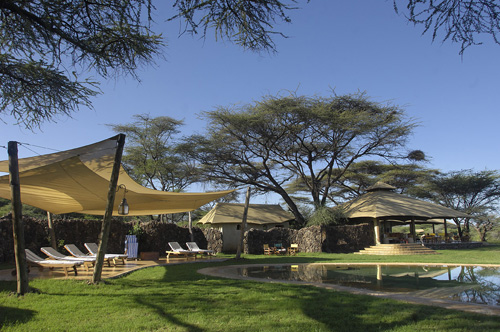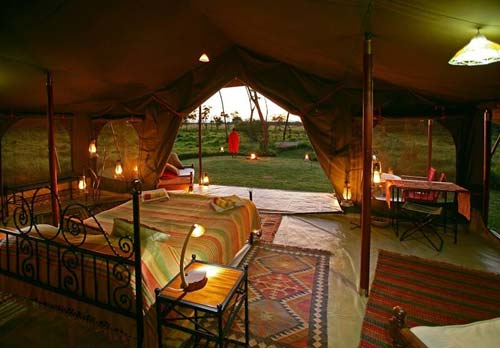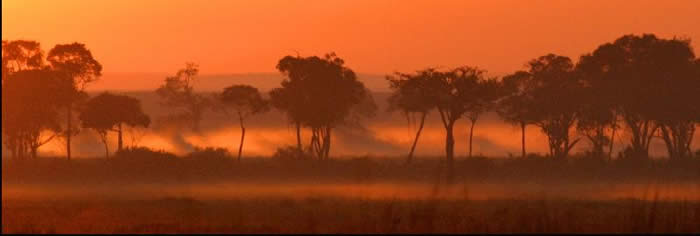Online Newsletter
We are delighted to present this amazing 6-night safari. Please telephone the office for details.
2 x nights Tortilis, 2 x nights Joy's Camp and 2 x nights Elephant Pepper Camp
Tortilis Camp
One cannot be more awe-inspired by the contrasts and enormity of the African landscape than upon arrival at this award-winning, ecotourism lodge in Amboseli National Park. Built with a sensitive eye to its surrounding environment, Tortilis Camp sits nestled in a verdant acacia grove at the foot of the majestic, snow-capped peak of Mount Kilimanjaro. Luxury tents with private en-suite bathrooms and unrivalled views of the mountain make this the ultimate place from which to get up close & personal with the abundant wildlife, especially Amboseli’s famous land leviathan, the African Elephant.
Joys Camp
An elegant oasis in the arid lands of Samburu; Joy’s Camp is built on the site of Joy Adamson’s tented home in Shaba National Reserve. The site was also home to Penny the leopard, the heroine of her last book
.
The 10 chic canvas bedrooms are set raised off the ground with breathtaking views of the surrounding hills. The camp overlooks a large natural spring where elephant and lion jostle for watering rights with herds of buffalo and the rare desert species of Beisa Oryx, Reticulated Giraffe and Grevy’s Zebra.
Each sumptuous tent is uniquely decorated with Boran/Somali cloth design, handmade glass and the vibrant fabrics of the local nomadic tribes creating a chic, sophisticated and stylish camp. Each tent has it’s own private verandah, ideal for private game viewing as well as relaxing, reading and soaking up the truly wild environs offered by Shaba. The eastern corner of the Samburu eco-system, Shaba is a secluded idyll; an arid landscape dotted with lush springs and rocky river gorges.
Joy’s Camp is the perfect choice for discerning guests interested in a glimpse of Kenyan history, as well as those looking for an authentic wildlife experience combined with the comfort of a luxury-tented camp.
Elephants Pepper Camp
 Situated right on the Northern Edge of the Maasai Mara reserve this 8-tented bush camp, is tucked away in a prime wildlife area. Surrounded by the Mara’s ubiquitous game, it’s a seasonal camp, which is taken down for a month or so in the rainy seasons. Situated right on the Northern Edge of the Maasai Mara reserve this 8-tented bush camp, is tucked away in a prime wildlife area. Surrounded by the Mara’s ubiquitous game, it’s a seasonal camp, which is taken down for a month or so in the rainy seasons.
Elephant Pepper Camp has been recently refurbished and designed to attract and introduce people to an authentic Masai Mara wildlife Safari Experience. Elephant Pepper Camp (originally Mara Bush Camp) offers a unique, comfortable environment and is aptly named after the Warburgia Ugandensis tree, which is commonly known as the Elephant Pepper tree.
The true bush experience of walking and unwinding around the glowing embers of a campfire all add to the authenticity of a true bush experience. Creative comforts are not sacrificed either with ensuite bathrooms being part of each spacious tent. Looking from the camp across the plains one can see the ‘greatest game show on earth’ when the annual wildebeest migration thunders past to seek new grazing in the lush savannahs of the Maasai Mara.
|
|

|
April Game Report Masai Mara
The rainy season is upon us and April brought warm mornings and humid afternoons with short rainstorms in the late afternoon and evenings. There is nothing quite like sleeping in a tent with the pitter-patter of rain falling on your roof! Morning temperatures of 18°C have given way to warm mid day temperatures of 32°C encouraging new growth and new life in the Mara ecosystem. The Musiara Marsh has filled with water and the surrounding plains are showing good signs of growth. We have had 2 film crews in camp this month recording the action and the drama of the Mara as it unfolds. The nightly rain showers and morning mists have caused wild mushrooms to sprout on elephant dung and given us some beautiful sunrises.
 
The Marsh is now home to lots of catfish and they in turn have been drawing fish eagles in, who perch in the trees surrounding the Marsh and dive into the waters to catch their prey. The rain has also meant that there is abundant insect life around especially grasshoppers and this is keeping the birds well fed. Common Kestrels fly in large flocks over the plains hunting grasshoppers and mice. European White Storks and Cattle Egrets comb the fringes of the Marsh feeding on grasshoppers and frogs and Ground Hornbills are out on the plains feasting on frogs and grass snakes.
The new growth on the grasslands is drawing the families of elephant out from the forests. Large herds of elephant with up to 30 members of related family units with very young calves are feeding on the tender young shoots on the plains. There are a few males in Musth and two females were seen mated.
The resident giraffe are ever present within the Musiara area. Large numbers of them with many young calves in crèches are between the fringes of the forest and the camps. Within the woodland verges and the marsh there are Defassa Waterbuck with their young calves and breeding herds of Impala. On the edges of the forest, furtive bushbuck move between the shadows and groups of Olive Baboons comb the grasslands around the marsh looking for food.
 
The resident warthog have also been busy mating. The boars have been sparring for females in oestrus, these males make a noticeable 'cluck' as they approach the oestrus sows.
Small bachelor herds of Grants Gazelle are resident in the grasslands near the forest and Cokes Hartebeest graze on the short grass flats near the marsh where there is an abundance of tender green grass shoots. There are good numbers of topi up on the ridges and high plains, these areas have high vantage points (often old termite mounds) that are used by both males and females. Males use these mounds to display the boundaries of their territory and the females use the mounds to alert others of danger. Territorial males have exclusive rights to the females. Males will mate when they are about fours of age and females will give birth when they are about two years old and the young will stay with their mother until the next calf is born.
The new growth in the grasslands has also been sustaining a large herd of Cape Buffalo with many young calves and a herd of resident eland. The new shoots of grass have also brought in large numbers of zebra and wildebeest with their calves, this is unusual as we normally expect to see the large herds of zebra and wildebeest arriving later on in the year.
During the warm midday hours the resident crocodile like to bask on Mara River banks and on the 28th of April there were a lot of large crocodiles basking in the midday sun. Crocodiles are 'ectothermic' or cold blooded and like many other species of reptiles they have to bask often with their mouths open to regulate their body temperatures.
 
Family groups of hyena have been denning up on the ridges and there are lots of hyena cubs around at the moment. One den is home to 14 cubs from three different age groups.
On the feline front the Bila Shaka / Marsh Pride have been seen daily in the areas surrounding the marsh. For a few days in the month two of the females and three 4 month old cubs separated themselves from the rest of the pride and took up residence in grasslands near the entrance to Little Governors'. But the pride as a whole has been feeding well especially on zebra. This pride now numbers 14 individuals and towards the end of the month they were all re-united together with the two dominant pride males.
On the morning of the 17th of April a few members of the Paradise/Ridge pride crossed the Mara River at a point in the river where the water levels are lower and there are many rocks. These lion use this section of the River to regularly cross back and forth, particularly when the water levels have dropped.
The coalition of 6 male lions with "Notch" (the uncle to the 5 other young males) are resident on the high plains. They have been feeding off Buffalo and Hippo and together they make a formidable unit.
 
The presence of a lot of hyena and baboons around the marsh has meant that the leopards have retreated back into the forest this month. However the resident female leopard whose territory covers the marsh and adjacent forest has been making her presence felt and we have had some lovely sightings of her and her son Kijana.
Shakira the female cheetah and her three ten month old female cubs have been faring well. She has been hunting on the short grass plains and river beds and the whole family has been feeding off Thompson and Grants Gazelles.
The three male cheetah brothers have been hunting impala, topi and wildebeest calves on the ridges and high plains and another single female cheetah has been hunting out on the plains.
Back in camp dragonflies flit across the surface of the Little Governors' marsh.
We hope to share the magic of our corner of the Mara with you sometime soon.
We have some fantastic special offers on safaris at the moment and there is still time to book your migration safari.
|


|
|
|
|
 |